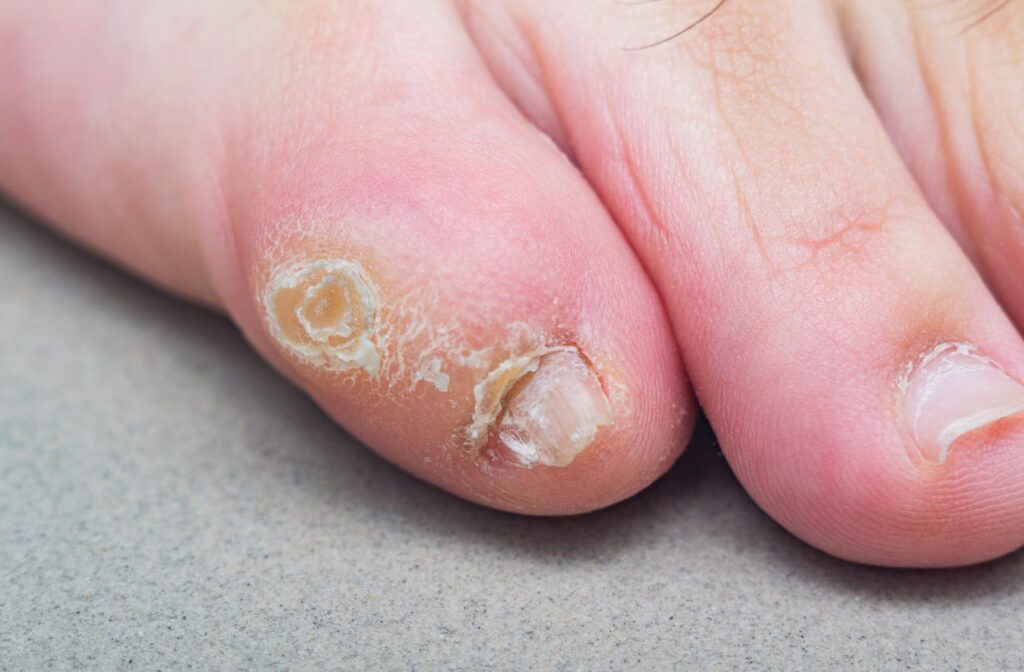Podiatrists see a broad range of problems every day. Most commonly people will attend if they are in pain or if they are unable to manage something on their own. The following outlines 5 of the most common foot health issues our Podiatrists see.

The most common foot health issues we see
1. Plantar fasciitis
Heel pain from plantar fasciitis is something our podiatrists see regularly. The plantar fascia is the thick connective tissue which supports the arch of your foot. Plantar fasciitis occurs when this band becomes irritated and inflamed and tiny tears occur anywhere along the tissue. This is usually the result of repeated strain through the arch.
The pain is usually worse when getting out of bed in the morning or rising after sitting for a long period of time. It eases after taking a few steps as the inflammation moves from the site of irritation and spreads over the rest of the foot.
Treatment for plantar fasciitis initially involves supporting the foot with either strapping or footwear, resting and ice. If foot posture is an issue orthotics might be required.

2. Sever’s Disease
Sever’s Disease is one of the most common causes of heel pain in children. The correct medical term is calcaneal (heel bone) apophysitis. It is an inflammatory condition of the growth plate in the heel bone (calcaneus), often with associated pain in the achilles tendon. Sever’s usually occurs in children between the ages of 8-14 years. Boys and girls are both equally affected, although sporty children seem most prone to the condition.
Your podiatrist can help to reduce symptoms and pain as well as preventing recurrence. Treatments may include rest from sport, strapping, calf stretches, heel pads/lifts, footwear advice and orthotic therapy if foot posture is contributing to the condition.
3. Thickened nails
Thickened or deformed nails are a regular complaint in the podiatry office. Maybe the patient finds them unsightly, or just too difficult to cut. There are a few different reasons why someone would have a thickened or deformed nail.
Onychauxis is the medical term for thickening of the nail plate. They occur due to a buildup of the cells that make up your toenails. Possible causes are increased age, minor trauma from shoes, previous nail fungus, and nail psoriasis (an autoimmune disease).
Another reason for thick nails is Onychogryphosis. This is often referred to as “Ram’s horn nails”, due to their horn-like appearance. Onychogryphosis is most often due to genetics and failure to cut the nails for extended periods of time. It may also be caused by acute nail trauma, prior fungus infection, psoriasis or peripheral vascular disease.
Red or blackened nails are often due to dried blood underneath the nail plate, however, it is important to check it out as it could be a melanoma.
The good news is podiatrists can help with all of these nails. Even though you are unable to cut them, your podiatrist can. They may also reduce the thickness for you, so they appear more normal.

4. Corns and Callus
Corns and callus are another very common foot health issue podiatrists treat. Calluses are thickened, hard skin that occur on the foot in areas that receive increased friction or pressure. Corns are very similar but tend to be more centralised and penetrate deeper into the skin. They occur on the skin on the toes or beneath the foot and are often surrounded by callus.
Your podiatrist will remove the buildup of skin in a relatively painless way. This should give you immediate relief. They will then explore ways to prevent rapid reappearance with footwear advice or modification and offloading.
5. Ingrown nails
Another regular issue visiting the clinics are ingrown toenails. They can be extremely painful and occur when the edges of the nail curves and grows into surrounding skin, causing swelling and inflammation. If left untreated they can lead to an infection. Ingrown toenails can happen on any toe but mostly on the big toe. They are often recurring unless you take measures to prevent them from happening again.
Your podiatrist can treat ingrown nails with conservative trimming or more permanently remove the section with a partial nail avulsion. Advance Foot Clinic now also offers Onyfix nail correction system which can brace your nail and may return it back to a more normal shape over time.Your podiatrist will also be able to check for any other factors, such as incorrect footwear, that might be the cause of your problem and help you to modify them.
Recognise one of these common foot health issues?
This was just a small selection of the common foot health issues seen in our clinics. If any of the above seemed familiar to you, feel free to book your appointment today with one of our podiatrists to discuss how to treat your individual foot health concerns.


